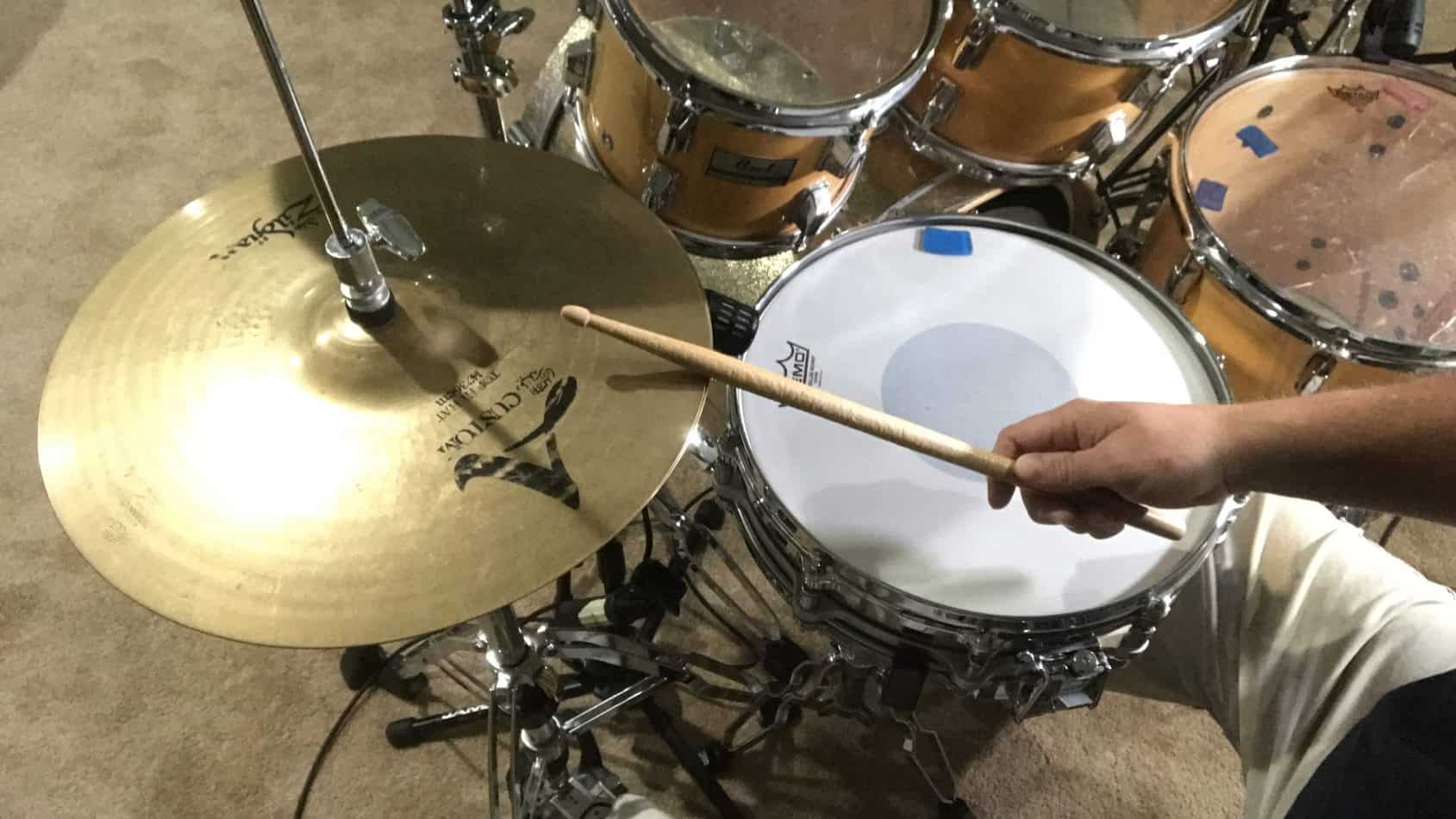The hi-hat is one of the most important instruments on the drum set. For many drummers, it may even be the most important one. I have a hard time playing favorites, but I do have a long list of hi-hat sounds that I think work really well.
Beyond having hi-hat cymbals that sound good and a stand that works properly, it’s important to have a variety of techniques to access all of the possible sounds.
The following list explores different stick and foot techniques to help level up your hi-hat sounds.
If you want information about how to set up your hi-hat stand, this article includes the steps and some do’s and don’ts.
1. Shoulder on the edge
The shoulder of the stick on the edge of the cymbals is a technique that I talk about a lot on Rhythm Notes. Different drummers will use this technique with varying angles of attack, depending on the height of the cymbals.
The angle of attack is something you should play around with to find the sound you like the most, which can be different from one song to the next.
This technique works for open or closed hi-hats, quarter notes or 8ths. If your playing quarter notes on the downbeats, “Tush” by ZZ Top is the first song that comes to mind.
The should on the edge technique goes well with the next sound on this list to establish accented and unaccented notes, yet it stands alone as a critical sound for drummers to employ.
2. Tip on the top
The tip of the stick doesn’t make too much sense on the edge of the cymbal, but it’s perfect for the top. This is a great area of the instrument to play rolls and unaccented notes.
The rolls cut through mixes while still being subtle, and the unaccented notes establish a dynamic and timbre contrast with accented notes played with the shoulder on the edge.
I can’t think of a clearer example than Carter Beauford’s intro on “#41.” The quieter inner beats of Carter’s playing are as important as the obvious big hits coming from his kit.
Notice in the video below how he writes such critical parts for this song and how much those parts rely on the tip of his stick on the top of the hi-hats.
Related: Open Handed Drumming – Why This Cymbal Technique is Better
3. Degrees of open hats
Hi-hats are not either open or closed. There are several degrees to being open or closed. Wide open hats are ringy and harder to control, whereas slightly open hats can be more predictable yet still sizzle a bit.
Try playing the hi-hats from tightly together, then slowly release them with your foot. As you release the pedal and strike the cymbals, listen to all of the different sounds you can make.
With all of these degrees of open or closed, you have a wide range of ways to phrase songs in terms of dynamics and timbre.
The wide open hi-hats, for example, in the beginning of “Killing in the Name of” by Rage Against the Machine comes to mind. When you hear the open and wild guitar of Tom Morello, Brad Wilks hats are simply matching the energy and supporting the music.
4. Pea Soup
The hi-hat slurp (or pea soup) is when you play the hi-hat and raise the top hat a bit before closing it on a downbeat or upbeat. For example, if the cymbal pattern is 8th notes, the slurp may start on the upbeat and your foot will come down on the pedal on the downbeat.
Slurps can also be on the downbeat. The drum beat for “American Girl” by Tom Petty has a downbeat slurp that I think is crucial to the groove.
The first example that comes to mind with slurps on the upbeats of the groove is “Sultans of Swing” by Dire Straits. Maybe it’s because I was thinking about Tom Petty and my memory was primed for that style of rock, but it’s really cool how the slurps support the changes in the chord progression.
5. Foot chick possibilities
The foot chick is simply when you play the hi-hat with your foot. The pedal is released to raise the top hat, and your foot pushes the pedal down to bring the cymbals together, making a “chick” sound.
A lot of drummers play grooves with the chick on beats 2 and 4 when they’re playing a pattern on another cymbal, a tom, or a percussion percussion instrument like cowbell. Drummers also play the foot chick on all four downbeats to thicken up a groove or add some time to support the space left by other instrumental parts of the song.
My favorite example of the foot chick hi-hat sound being significant in a groove is “Good Times Bad Times” by Led Zeppelin. John Bonham starts the song with quarter notes on the downbeats and adds 8th notes the second measure before adding a cowbell on the third.
6. Splash With Foot
A splash of the hi-hat with your foot is a technique that you usually see in jazz or from jazz drummers playing other styles of music. The splash is like a chick but the pedal is released right after the top and bottom hi-hat cymbals make contact.
I can remember the first time I had to transition from brushes to sticks in a song. I didn’t know how to keep the energy of the groove going. My teacher simply said, “Splash your hi-hats.” I immediately knew that he meant with my foot. That gave me time to switch implements and pick up into the next section of the song.
7. Splash-Chick Ostinato
If you combine the foot chick with the with splash and play one right after the other repeatedly, you will have what I call the “splash-chick” ostinato. The technique is easier to execute if you think about the foot playing the chick part with the front of your foot and the splash with the heel of your foot toward the back of the pedal.
Terry Bozzio is known for foot ostinatos with improvised solos with his hands. Many of the ostinatos include a hi-hat with a splash-chick technique. The example below doesn’t show his remote hi-hat playing the ostinato, but you can hear it. And if you’ve ever seen Terry play, you can visualize what it looks like.
8. Add a Toy
My toy of choice to add to the hi-hats is either a tambourine or a shaker, like goat nails. The toy adds a little dirt to the sound and can be more or less chaotic, depending on what you place on the cymbals or how it is mounted.
The Meinl Ching Ring, for example, is designed to rest on the top hi-hat cymbal. It can move a little but not much. Other designs clamp the tambourine to the hi-hat rod, like the Meinl THH1BK Hi-Hat Tambourine. This provides more stability and predictability because it’s not moving freely on the cymbals.
If you’re interested in the products mentioned above, use the links to check the prices on Amazon.
Placing toys like goat nails or other string of dry jingles can add a desirable chaos or mess to the hi-hat sound. Plus, these toys, like the Ching Ring, can be placed on the top of the hi-hat loosely, making it easy to add or remove them for different songs in a set.
Final Thoughts
These hi-hat techniques can be used to write a lifetime’s worth of song phrasing. Combine these techniques with different rhythmic possibilities, and the sound variations seem to be infinite.
Most importantly, have fun with these techniques. I wrote this article because they are fun and inspiring to me. I’ll play a chick-splash ostinato and improvise for 15 minutes if I need to get into a creative flow.
Related Articles
Ride vs. Crash – 11 Cymbal Sounds You Can Make
9 Different Types of Cymbals to Complete Your Drum Set
7 Considerations When Buying Splash Cymbal Mounting Hardware
5 Free Drum Lessons – Intermediate (see Lesson 2)


